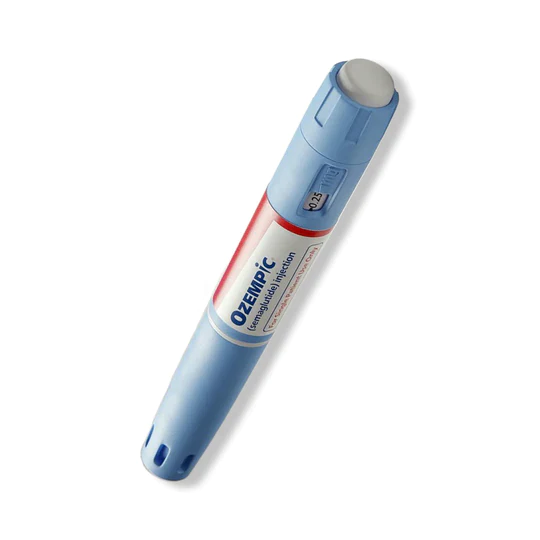Ozempic®
The amount of weight loss experienced with Ozempic can vary from person to person, as individual responses to the medication and lifestyle factors can play a role. Clinical studies have shown that on average, people taking Ozempic may lose up to 15% of their initial body weight over a period of several months to a year.
It’s essential to remember that combining Ozempic with a balanced diet and regular exercise will increase the likelihood of achieving your weight loss goals. Always consult your healthcare provider for personalized advice on weight loss expectations and a tailored approach to your health journey.
While Ozempic (semaglutide) has been proven effective for weight loss, it may also cause some side effects. It is important to note that not everyone will experience these side effects, and they may vary in severity. Some common side effects of Ozempic include:
- Nausea
- Vomiting
- Diarrhea
- Constipation
- Abdominal pain
- Bloating or gas
- Decreased appetite
- Fatigue
- Headache
- Dizziness
If you experience any side effects while using Ozempic, contact your healthcare provider via our chat immediately. They may be able to help you manage the side effects or adjust your treatment plan accordingly.
Ozempic (semaglutide) is administered as a subcutaneous injection, which means it is injected just under the skin. Here’s a general overview of how to take Ozempic:
- Dosage and Frequency: Ozempic is typically prescribed as a once-weekly injection. Your healthcare provider will recommend the appropriate starting dose and may adjust it over time based on your response to the medication.
- Injection Site: The common injection sites for Ozempic include the abdomen (avoiding the area around the navel), thigh, or upper arm. Rotate the injection sites to reduce the risk of skin irritation or discomfort.
- Preparation: Read and follow the instructions provided with Ozempic on how to prepare the injection pen, attach the needle, and select the correct dose.
- Injection Process: Clean the injection site with an alcohol swab and let it air dry. Pinch the skin gently, insert the needle at a 90-degree angle, and press the injection button to administer the dose. Release the pinched skin and withdraw the needle gently.
- Disposal: Safely dispose of the used needle in a sharps container, as per local regulations. Never reuse or share needles.
Ozempic is generally safe and well-tolerated when used as directed by a healthcare provider. However, it is essential to be aware of some key safety information to ensure safe and effective use:
- Contraindications: Do not use Ozempic if you have a personal or family history of medullary thyroid carcinoma (MTC) or Multiple Endocrine Neoplasia syndrome type 2 (MEN 2). Ozempic is also contraindicated if you are allergic to semaglutide or any of its components.
- Pancreatitis: Ozempic may increase the risk of pancreatitis. If you experience severe abdominal pain, nausea, vomiting, or any other symptoms suggestive of pancreatitis, contact your healthcare provider immediately.
- Hypoglycemia: Ozempic may lower blood sugar levels, especially when used in combination with other diabetes medications like insulin or sulfonylureas. Be aware of the signs of low blood sugar (hypoglycemia) and monitor your blood glucose regularly.
- Diabetic Retinopathy: In people with a history of diabetic retinopathy, Ozempic may increase the risk of further complications. Regular eye examinations are recommended.
- Kidney problems: Ozempic may cause or worsen kidney problems. If you have a history of kidney disease or notice any signs of kidney problems (e.g., changes in urine output, swelling in your legs or feet), inform your healthcare provider.
- Allergic reactions: Ozempic may cause allergic reactions, including itching, rash, or difficulty breathing. If you experience any signs of an allergic reaction, seek immediate medical attention.
- Pregnancy and breastfeeding: The safety of Ozempic during pregnancy and breastfeeding is not well-established. Discuss the potential risks and benefits with your healthcare provider if you are pregnant, planning to become pregnant, or breastfeeding.
This list is not exhaustive, and it is crucial to discuss any medical conditions or concerns with your healthcare provider before starting Ozempic.

